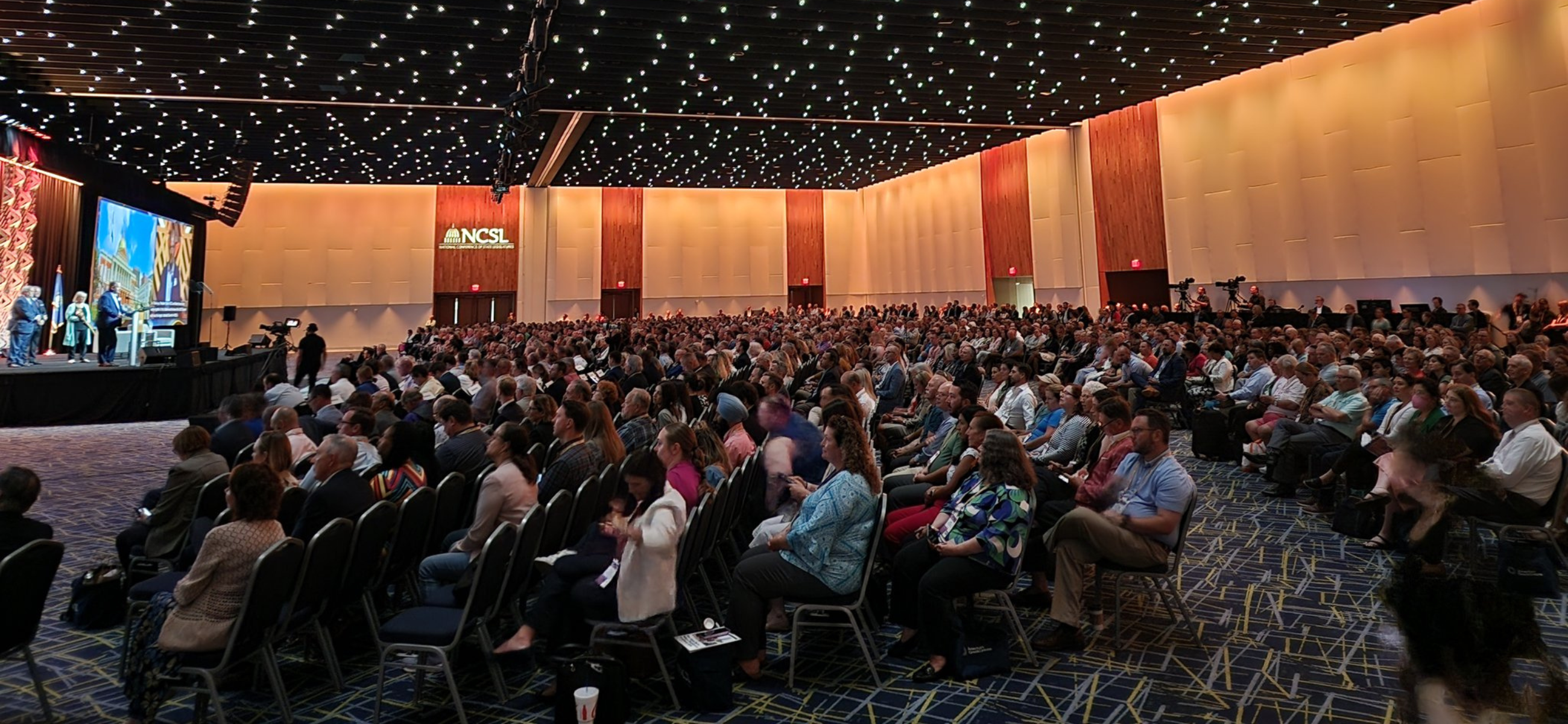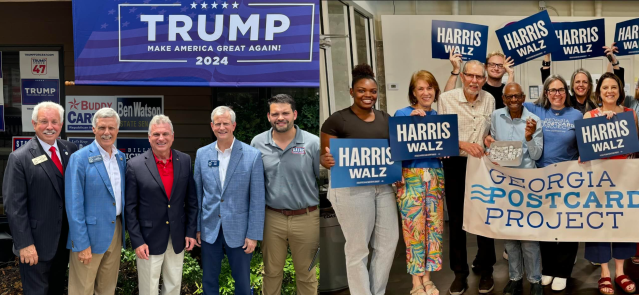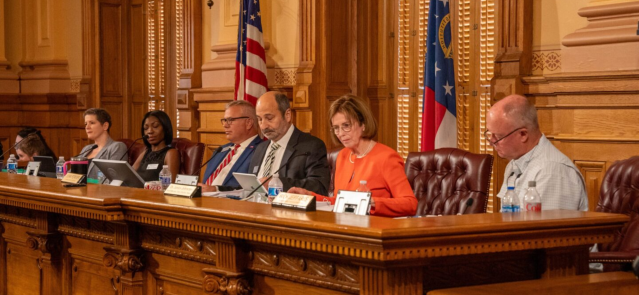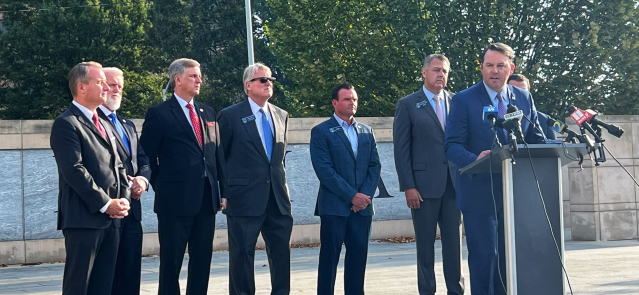Stay ahead of the curve as a political insider with deep policy analysis, daily briefings and policy-shaping tools.
Request a DemoNCSL: Experts say start building 2030 redistricting checklist now

Lawmakers and staffers gather for the National Conference of State Legislatures annual summit in Louisville. (Credit: NCSL)
- Lawmakers encouraged to make plans to preempt potential challenges they’re bound to face
- States must determine the criteria they use and how that criteria is determined, expert says
- Creating commissions requires consideration of multiple factors
The next redistricting cycle is several years away, but those involved with various states’ processes on Wednesday implored lawmakers to begin preparing now.
Their message was delivered at a National Conference of State Legislatures summit session intended to preempt challenges states may face when it comes to inmate data reallocation, commissions, map criteria, public input and remedial mapmaking.
Karin Mac Donald, director of the California Statewide Database, said that when it comes to inmate data reallocation — the process of adjusting the residency record of inmates — “start early and make a plan.”
California’s process took several years and required collaboration between her office, lawmakers, the department of corrections and the Census Bureau.
She advised thinking about whether new legislation is required, if technical changes are needed, and whether the funding, software, staff or training is in place to execute the process.
She also suggested becoming familiar with the data sets and securing a test file from the department of corrections in advance to learn how to clean addresses manually or with the help of software tools, set thresholds for minimum acceptable level of confidences and more.
Jonathan Cervas, an assistant teaching professor at Carnegie Mellon Institute for Strategy and Technology, said states also need to think about who is making their maps.
While most states enact maps through their legislatures, some use commissions that can include legislators, citizens or both and whose maps may or may not require legislative approval. Membership across the country ranges from four members to 16.
Arizona’s commission consists of four citizens appointed by legislators and a fifth citizen commission chair who may not be a member of either major political party. Its maps become law without legislative intervention, Cervas said.
In developing the commissions, Cervas said several items need to be considered including the number of members, whether that number is odd or even, how maps are approved, the level of involvement by the legislature, and the overriding criteria for developing a map.
There are also the “functional problems,” he said, like how commissions are budgeted, how staff are hired, how long it should exist, and how members are compensated.
“I don’t think anyone has a good answer on the proper way to construct a commission,” he said.
Because each state operates so differently, Cervas said there is not a reliable study on best practices as it is difficult to pinpoint which aspects of each plan works best.
Still, he said, citizen commissions are “seen as the gold standard if your goal is to take politics out of it.”
Helen Brewer, an NCSL policy specialist, said states must determine not only the criteria by which they draw maps, but also how those criteria rank.
Michigan, for example, requires contiguity above all, followed by preservation of communities of interest, avoiding intentionally favoring a political party, avoiding intentionally favoring an incumbent or candidate, preserving political subdivisions, and lastly, compactness.
In contrast, Missouri prioritizes compactness first, followed by contiguity, preservation of political subdivisions, proportionality and competitiveness.
They are among five states that rank criteria either in statute or in the constitution, while others set criteria more informally.
Brewer said a strict ranking provides map makers with clear instructions, but cautioned that “mapmakers are dealing with infinite and sometimes conflicting data points, so they may need more flexibility.”
Quyen Do, deputy research director of the Oklahoma legislature, said her state implemented several measures to facilitate public input.
Some were “low-hanging fruit,” like setting up an email and dedicated website with an online feedback form.
Others required more planning, like holding 30 regional town halls that were recorded and live streamed, providing public training on how to use Dave’s Redistricting and allowing public map submissions.
Lawmakers should also consider whether hearings are held before or after draft maps are created and how public input is collected, stored, collated and reviewed, she said.
Jeff Wice, special counsel for the New York legislature, explained that remedial mapmaking occurs when there is a legislative impasse, if a commission implodes, as was the case in New York and Virginia, or if a court finds a violation and requires a new map.
In those situations, a court may hire a “special master” to take the lead in drawing remedial maps, he said.
NCSL advised states to consider whether political parties may submit nominees for the special masters, what rules they must follow, whether states or redistricting commissions will have to provide staffing and facilities for remedial processes and whether they will have to cover the cost of remedial mapmaking.
Krista Kano is a staff writer for Gongwer Ohio/State Affairs. Reach her at [email protected] or on X @krista_kano.
Presidential race aside, what’s at stake for Georgians in the November election?
The Gist Despite all 236 members of the state House and Senate up for reelection in November, the presidential race has taken center stage in Georgia with the nomination of Vice President Kamala Harris for U.S. president. Nonetheless, Georgia Democrats will be in a push-and-pull contest to gain more seats in both the House and …
Election administrators ‘in limbo’ over new voting rules, top official says
If you plan to hand-deliver your absentee ballot to your local election office this year, you’ll have to show identification and sign a form stating whose ballot you’re dropping off, under a new rule recently passed by the State Election Board. If you fail to show your ID or don’t complete the form, your ballot …
Weekend Read: State Election Board marks its 60th year mired in controversy. Here’s what happened.
In 1964, Georgia lawmakers retooled the state’s election process to create a “one person, one vote” system after the U.S. Supreme Court outlawed the “county unit system” that held sway over Peach State politics for nearly half a century. Until then, politicians hoping to win primaries in Georgia had to capture entire counties, not just …
State lawmakers: Atlanta, give detention center to Fulton to fix problem-plagued jail
Atlanta city officials need to give the Atlanta Detention Center to Fulton County to ease overcrowding in the county’s violence-prone jail, a bipartisan panel of state lawmakers said in its final report, released Friday. “A big part of the solution is that the City of Atlanta needs to turn over the Atlanta Detention Center to …




